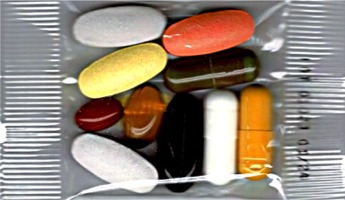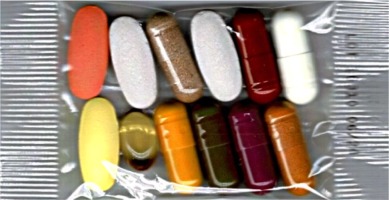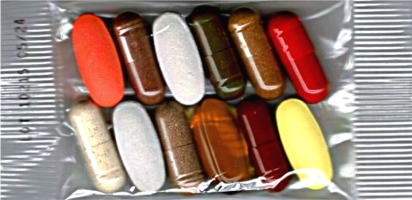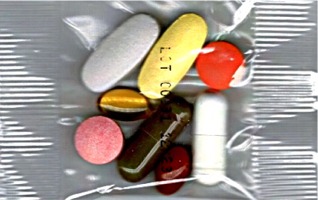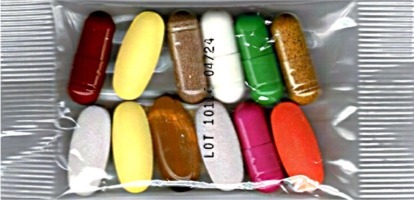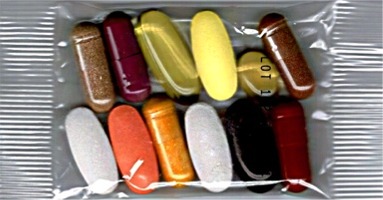
ANR Heart Formula
Phytonutrients & Nutraceuticals:
|
|
This information is designed to help adults make informed decisions about their health and is intended to be used for general nutritional information and educational purposes only. It is not intended to prescribe, treat, cure, diagnose or prevent any particular medical problem or disease, or to promote any particular product. Women who are pregnant or nursing should always consult with their doctors before taking any supplements. You should always consult your health care professional for individual guidance for specific health concerns. Persons with medical conditions should seek professional medical care. Anyone may link to this page. |
|
Phytonutrients & Nutraceuticals: OverviewBy Marcia Zimmerman C.N. "Nutraceuticals." "Phytochemicals." "Phytonutrients." "Phytofoods." "Functional foods." Who dreamed up this new terminology? What do these terms mean? Nutritionally high-powered foods aren't new to the natural products industry--we have been selling nutrition-rich foods such as whole grains, lecithin, brewer's yeast and soy products for over 60 years. What is "new" about these foods, however, is science's added knowledge about the disease-preventing components they contain. Stephen de Felice, M.D., director of New York's Foundation for Innovation in Medicine, is credited with first use of the term nutraceutical. It describes specific chemical compounds found in foods that may prevent disease. Phytochemical is a more recent evolution of the term that emphasizes the plant source of most of these protective, disease-preventing compounds. A true nutritional role for phytochemicals is becoming more probable every day as research uncovers more of their remarkable benefits. In fact, the term phytonutrient better describes the compounds' "quasi-nutrient" status. Someday, phytochemicals may indeed be classified as essential nutrients. One finger pointing in this direction is a body of research that strongly links the importance of diet to health--studies are showing that as we move away from the diet of our ancestors we succumb to "modern" diseases. Evidence of this can be seen in societies such as the centenarian tribes that live in remote villages in the Andes Mountains and who still embrace traditional dietary practices. These people have been reported to live extraordinarily long lives that are free of such illnesses as cancer, heart disease and arthritis.1 Since few people live today as "naturally" as do the tribes in remote Andean villages, researchers have examined epidemiological evidence from modern societies for clues to the diet-disease connection. On the basis of such studies, biochemical researchers have identified certain phytochemicals that aid the body in maintaining health and combating disease. As an overall guideline, health authorities recommend that we consume diets rich in whole grains and fresh fruits and vegetables as well as reduce fat and animal-protein consumption.2 In the past, the phytonutrients found in fruits and vegetables were classified as vitamins: Flavonoids were known as vitamin P, cabbage factors (glucosinolates and indoles) were called vitamin U, and ubiquinone was vitamin Q. Tocopherol somehow stayed on the list as vitamin E. Vitamin designation was dropped for the other nutrients because specific deficiency symptoms could not be established. Recent research, however, has enabled scientists to group phytonutrients into classes on the basis of similar protective functions as well as individual physical and chemical characteristics of the molecules. Following is a look at each of the phytonutrient classes. It is fairly confusing to identify in which class a phytonutrient belongs, but this information is important to know because each class offers a unique kind of protection for the body. To play the "wellness game," however, all classes of phytonutrients need to be consumed. Key Topics: Overview
Terpenes Carotenoids
Limonoids Phytosterols
Phenols ANR Formula One,
Two, Three, Four,
Five, Six, Seven TerpenesTerpenes such as those found in green foods, soy products and grains, comprise one of the largest classes of phytonutrients. The most intensely studied terpenes are carotenoids--as evidenced by the many recent studies on beta carotene. The terpenes function as antioxidants, protecting lipids, blood and other body fluids from assault by free radical oxygen species including singlet oxygen, hydroxyl, peroxide and superoxide radicals. Terpenoids are dispersed widely throughout the plant kingdom, protecting plants from the same reactive oxygen species that attack human cells. ANR Formula One,
Two, Three, Four,
Five, Six, Seven CarotenoidsThis terpene subclass consists of bright yellow, orange and red plant pigments found in vegetables such as tomatoes, parsley, oranges, pink grapefruit, spinach and red palm oil. We even find carotenoids lending bright colors to animals; flamingos owe their color to carotenoids, as do shellfish. Egg yolks are yellow because of carotenoids that protect the unsaturated fats in the yolk. The carotenoid family actually includes two distinct types of molecules. One type, the carotenes, are chemically classified as 40-carbon tetraterpenes, which do not include specific chemical features like hydroxyl or keto groups. This type of carotenoid includes the familiar molecule beta carotene. The second type of carotenoids, the xanthophylls, includes the chemical compounds known as the carotenoid alcohols and keto-carotenoids. In this second category are included the molecules zeaxanthin, cryotpxanthin, and astazanthin. There are more than 600 naturally occurring carotenoids. Most people think of this family of phytonutrients as being precursors to vitamin A, but fewer than 10 percent have vitamin A activity. Among the carotenes, only alpha, beta and epsilon carotene possess vitamin A activity. Of these, beta carotene is the most active. Alpha carotene possesses 50 percent to 54 percent of the antioxidant activity of beta carotene, whereas epsilon carotene has 42 percent to 50 percent of the antioxidant activity. The above-mentioned carotenes, along with gamma carotene and the carotenes lycopene and lutein, which do not convert to vitamin A, seem to offer protection against lung, colorectal, breast, uterine and prostate cancers.3 Carotenes are tissue-specific in their protection. Overall protective effects are therefore greater when all carotenes are taken together. Carotenes also enhance immune response and protect skin cells against UV radiation.4 Additionally, they "spare" the glutathionine Phase II detoxification enzymes in the liver that we rely on to safely eliminate pollutants and toxins from the body. The xanthophyll type of carotenoids also include many interesting molecules. One xanthophyll, canthaxantin, was popular as a tanning pill a few years ago. It migrates to the skin and protects it from sunlight. Other important xanthophylls are cryptoxanthin, zeaxanthin and astaxanthin. Xanthophylls are important because they appear to protect vitamin A, vitamin E and other carotenoids from oxidation. Evidence is emerging that xanthophylls are tissue specific. Cryptoxanthin, for example, may be highly protective of vaginal, uterine and cervical tissues.5 ANR Formula One,
Two, Three, Four,
Five, Six, Seven LimonoidsThis terpene subclass, found in citrus fruit peels, appears to be specifically directed to protection of lung tissue. In one study, a standardized extract of d-limonene, pinene and eucalyptol was effective in clearing congestive mucus from the lungs of patients with chronic obstructive pulmonary disease. Additionally, limonoids may be specific chemopreventive agents. In animal studies, results suggest that the chemotherapeutic activity of limonoids can be attributed to induction of both Phase I and Phase II detoxification enzymes in the liver.6 ANR Formula One,
Two, Three, Four,
Five, Six, Seven PhytosterolsSterols occur in most plant species. Although green and yellow vegetables contain significant amounts, their seeds concentrate the sterols. Most of the research on these valuable phytonutrients has been done on the seeds of pumpkins, yams, soy, rice and herbs. Phytosterols compete with dietary cholesterol for uptake in the intestines. They have demonstrated the ability to block the uptake of cholesterol (to which they are structurally related) and facilitate its excretion from the body. Cholesterol has long been implicated as a significant risk factor in cardiovascular disease. Are other dietary factors important as well? To answer this question, a research team in Los Angeles conducted a study to test the importance of other dietary factors in modifying the risk of cholesterol levels. They compared the diets of 169 Seventh Day Adventists--vegans, lacto-ovo and non-vegetarians--with general population non-vegetarians all living in Los Angeles in the mid 1980s. It was found that the ratio between dietary plant phytosterols and cholesterol was significantly lower in SDA vegetarians as compared to non-vegetarians. The importance of this study underlies the fact that cholesterol, per se, is not the only marker of risk for cardiovascular disease and that its ratio with other modifying dietary components may be a better measure of risk.6 Other investigations have revealed that phytosterols block the development of tumors in colon, breast and prostate glands. The mechanisms by which this occurs are not well understood, but we do know that phytosterols appear to alter cell membrane transfer in tumor growth and reduce inflammation. ANR Formula One,
Two, Three, Four,
Five, Six, Seven PhenolsThese phytonutrients comprise a large class that has been the subject of extensive research as a disease preventive. Phenols protect plants from oxidative damage and perform the same function for humans. Blue, blue-red and violet colorations seen in berries, grapes and purple eggplant are due to their phenolic content. Bilberries, for example, are high in phenolic anthocyanidins and are red in color. The outstanding phytonutrient feature of phenols is their ability to block specific enzymes that cause inflammation. They also modify the prostaglandin pathways and thereby protect platelets from clumping.7 ANR Formula One,
Two, Three, Four,
Five, Six, Seven FlavonoidsPhytonutrients of this phenol subclass enhance the effects of ascorbate-vitamin C. Flavonoids were once lumped together as vitamin P, but there are well over 1,500 of them. Here is a partial listing: * Flavones (containing the flavonoid apigenin found in chamomile); * Flavonols (quercetin--grapefruit; rutin--buckwheat; ginkgoflavonglycosides--ginkgo); * Flavanones (hesperidin--citrus fruits; silybin--milk thistle); The biologic activities of flavonoids include action against allergies, inflammation, free radicals, hepatotoxins, platelet aggregation, microbes, ulcers, viruses and tumors.8 Flavonoids also inhibit specific enzymes. For example, flavonoids block the angiotensin-converting enzyme (ACE) that raises blood pressure: By blocking the "suicide" enzyme cyclooxygenase that breaks down prostaglandins, they prevent platelet stickiness and hence platelet aggregation. Flavonoids also protect the vascular system and strengthen the tiny capillaries that carry oxygen and essential nutrients to all cells.9 Additionally, flavonoids block the enzymes that produce estrogen, thus reducing the risk of estrogen-induced cancers. One way they do this is by blocking estrogen synthsase, an enzyme that works overtime in binding estrogen to receptors in several organs.10 Although their way of doing so is not yet fully understood, flavonoids also appear to retard development of cataracts in individuals with inborn errors in sugar metabolism such as diabetes.11 Cataracts can be a complication of diabetes because diabetics, unable to metabolize sugar normally, build up damaging levels of "alcohol sugars." These in turn cause clouding of the lens of the eye (cataract). It is suspected flavonoids prevent cataracts by blocking aldose-reductase (a digestive enzyme), which can convert the sugar galactose into the potentially harmful form of galacticol. ANR Formula One,
Two, Three, Four,
Five, Six, Seven AnthocyanidinsThis select group of flavonoids deserves special attention. Technically known as "flavonals," they provide crosslinks or "bridges" that connect and strengthen the intertwined strands of collagen protein. Collagen is the most abundant protein in the body, making up soft tissues, tendons, ligaments and bone matrix. Its great tensile strength depends on preservation of its crosslinks. Anthocyanidins, being water soluble, also scavenge free radicals they encounter in tissue fluids. This is a powerful ability especially beneficial for athletes and others who exercise, because heavy exercise generates large amounts of free radicals. ANR Formula One,
Two, Three, Four,
Five, Six, Seven Catechins, Gallic AcidsCatechins differ slightly in chemical structure from other flavonoids, but share their chemoprotective properties. The most common catechins are gallic esters, named epicatechin (EC), epicatechin gallate (ECG), and epigallocatechin gallate (EGCG). All are found in green tea, Camellia sinensis, and are thought to be responsible for the protective benefits of this beverage.13 ANR Formula One,
Two, Three, Four,
Five, Six, Seven IsoflavonesPhytonutrients of this phenol subclass come from beans and other legumes and are distant cousins of flavonoids. Isoflavones function much like flavonoids in that they effectively block enzymes that promote tumor growth. Best known isoflavones are genistein and daidzein found in soy products and the herb Pueraria lobata (Kudzu). People who consume traditional diets rich in soy foods rarely experience breast, uterine and prostate cancers. Pueraria has gained popularity as an aid for those who consume alcohol because it appears to alter the activity of alcohol detoxification enzymes, namely the speed at which alcohol dehydrogenase converts alcohol into aldehydes. The result is a lowered tolerance for alcohol and reduction of the pleasure response to drinking it.13 ANR Formula One,
Two, Three, Four,
Five, Six, Seven ThiolsPhytonutrients of this sulfur-containing class are present in garlic and cruciferous vegetables (i.e., cabbage, turnips and members of the mustard family). ANR Formula One,
Two, Three, Four,
Five, Six, Seven GlucosinolatesFound in cruciferous vegetables, glucosinolates are powerful activators of liver detoxification enzymes. They also regulate white blood cells and cytokines.14 White blood cells are the scavengers of the immune system and cytokines act as "messengers," coordinating the activities of all immune cells. Bio-transformation products of glucosinolates include isothiocyanates, dithiolthiones and sulforaphane. Each of these is protective of specific tissues. Their actions involve blocking enzymes that promote tumor growth, particularly in the breast, liver, colon, lung, stomach and esophagus.15 ANR Formula One,
Two, Three, Four,
Five, Six, Seven Allylic SulfidesGarlic and onions are the most potent members of this thiol subclass, which also includes leeks, shallots and chives. The allylic sulfides in these plants are released when the plants are cut or smashed. Once oxygen reaches the plants' cells, various bio-transformation products are formed. Each of these appears to have tissue specificity. As a group, allylic sulfides appear to possess antimutagenic and anticarcinogenic properties as well as immune and cardiovascular protection. They also appear to offer anti-growth activity for tumors, fungi, parasites, cholesterol and platelet/leukocyte adhesion factors. Garlic and onions, like their cruciferous relatives, can also activate liver detoxification enzyme systems. Specific allylic sulfides block the activity of toxins produced by bacteria and viruses.15 ANR Formula One,
Two, Three, Four,
Five, Six, Seven IndolesThis subclass includes phytonutrients that interact with vitamin C, which is not surprising since the vegetables that contain indoles also contain significant amounts of vitamin C. Indole complexes bind chemical carcinogens and activate detoxification enzymes, mostly in the gastrointestinal tract. The bio-transformation products of indoles are formed when they are acted on by stomach acid. The most active product is "ascorbigen," considered to be an active vitamin C "metabolite."16 ANR Formula One,
Two, Three, Four,
Five, Six, Seven IsoprenoidsIsoprenoids neutralize free radicals in a unique way. They have a long carbon side chain which they use to anchor themselves into fatty membranes. Any free radicals attempting to attach lipid (fat) membranes are quickly grabbed and passed off to other antioxidants. ANR Formula One,
Two, Three, Four,
Five, Six, Seven Tocotrienols And TocopherolsTocotrienols naturally occur in grains and palm oil along with their cousins, tocopherols. Toco-trienols appear to inhibit breast cancer cell growth, whereas tocopherols do not exhibit this effect. Researchers have observed that the biologic functions of tocopherols and tocotrienols appear unrelated.17 Tocotrienols have been most studied, however, for their cholesterol lowering effects. ANR Formula One,
Two, Three, Four,
Five, Six, Seven Lipoic Acid & UbiquinoneLipoic acid and ubiquinone (coenzyme Q) are important antioxidants that work to extend the effects of other antioxidants. In terms of research, lipoic acid is the "new kid on the block." It is an efficient hydroxyl radical quencher, its sulfur bond being the reactive part of the molecule. It is active on both lipids and tissue fluids. In addition to hydroxyl radicals, it scavenges peroxyl, ascorbyl and chromanoxyl radicals. Because it functions in both lipid and water phases, it is protective of both vitamin E and vitamin C. Lipoic acid also protects SOD, catalase and glutathione, which are all important in liver detoxification activities.18 The roles of both lipoic acid and ubiquinone as antioxidants have been discovered relatively recently. Both have important roles in energy production. Of course, no phytonutrient is actually "new"--it's only our understanding of them that's new. Research in this area is expanding rapidly because it appears that phytonutrients offer the best protection we know of against the diseases that plague us today. Will phytonutrient pills be the preferred "prescription" of tomorrow? As we understand more of the tissue-specific way in which these nutrients work, this may happen. Marcia Zimmerman, M.Ed., C.N., is C.E.O. of the consulting firm Marcia Zimmerman & Associates in Westlake Village, Calif. She has more than 15 years experience in the natural foods industry as a retailer, product formulator, educator and nutritional counselor. Key Topics: Overview
Terpenes Carotenoids
Limonoids Phytosterols
Phenols ANR Formula One,
Two, Three, Four,
Five, Six, Seven Article References:1. Walker, Morton. Secrets of Long Life, New York, Devin-Adair Publishers, 1993. 2. Dragsted, L.O., et al., Pharmacology and Toxicology, 72 Suppl. 1:116-35; 1993. 3. Bendich A., Olson J.A., FASB J, 3: 1927-32; Jan. 1989. 4. Bendich A., J Nutr, 119: 112-5; Jan 1989. 5. Parker R.S., J Nutr, 119: 101-4; Jan 1989.
7. Hertog, M.G., et al. Lancet, 342: 1007-11, Oct. 23, 1993. 8. Kinsella, J.E., et al. Food Technology, 47: 85-90, April 1993. 9. Ibid. 10. Northrup, C. Women's Bodies, Women's Wisdom: 305. New York; Bantam Books, 1994. 11. Murray, R.K., et al. Harper's Biochemistry, 23 ed.: 196. New York; Appleton & Lange, 1994. 12. Komori, A., et al. Jpn J Clin Oncol, 23: 186-190, June 1994. 13. Xie, C.I., et al. Alcohol Clin Exp Res, 18: 1443-7, Dec. 1994. 14. Zhang, Y., et al. Proc Natl Acad Sci USA,.91: 3147-50, April 12, 1994 1992. 15. Tadi, P.P. Diss Abstr Int (B), 52: 4144, 1992. 16. Bukhman, V.M. et al. Pharmacol Ther, 60: 301-313, 1992. 17. Hayes, K.C., et al. Exp Biol Med, 202: 353-359, March 1993. 18. Sumathi, R., et al. Pharmacol Res, 27: 309-318, May-June 1993. Key Topics: Overview
Terpenes Carotenoids
Limonoids Phytosterols
Phenols ANR Formula One,
Two, Three, Four,
Five, Six, Seven
Also see: ANR Formula One,
Two, Three, Four,
Five, Six, Seven |

